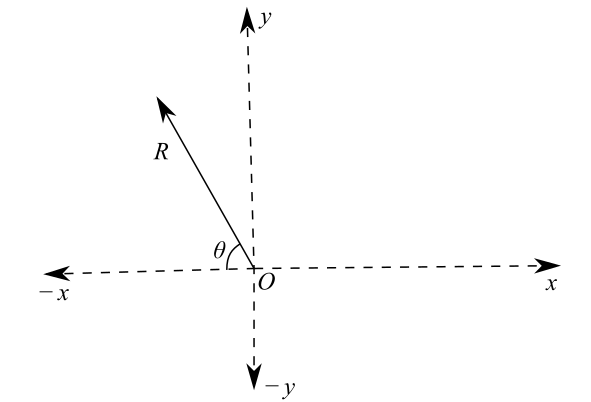
Concept explainers
Two forces act on a point object as follows: 100 N at
Find their resultant.
The resultant force due to the two forcesacting on an object, which are as follows:
Answer to Problem 42SP
Solution:
Explanation of Solution
Given data:
Two forcesacting on a point are as follows:
Formula used:
The resultant
Here,
The expression for the direction of the resultant force is
Here,
Explanation:
Draw the schematic diagram of the problem:

Find the x- and y-components of each force. These components are as follow:
| Force | x-component | y-component |
| Sum |
Recall the expression of the magnitude of the resultant:
Substitute
Draw a schematic diagram for the resultant of both forces.

In the above diagram,
Recall the expression of the angle:
Rearrange for
Substitute
This is the angle of the resultant with the negative x-axis. Therefore, the angle of the resultant with the positive x-axis should be
Conclusion:
The magnitude of the resultant is
Want to see more full solutions like this?
Chapter 3 Solutions
Schaum's Outline of College Physics, Twelfth Edition (Schaum's Outlines)
- If an object is in equilibrium there must be an even number of forces acting on it.arrow_forwardCheck Your Understanding Find the angle between forces F1and F3in Example 2.16.arrow_forwardA horizontal force of 430 N is applied to a stationary wooden box in one direction, and a 700 N horizontal force is applied in the opposite direction. What additional force is needed for the box to remain stationary?arrow_forward
- Three forces act on a point. : 3 N at 0 degrees, 4 N at 90 degrees, and 5 N at 217 degrees. What is the resultant? Select one: 4.4 N, 179.4 degrees 1.4 N, 135 degrees 1.4 N, 315 degrees 4.4 N, 0.59 degreesarrow_forwardThe figure shows a person whose weight is W = 782 N doing push-ups. Find the normal force exerted by the floor on (a) each hand and (b) each foot, assuming that the person holds this position.arrow_forwardFind the ratio of magnitude of forces?arrow_forward
- Find the magnitude of two equal forces acting at a point with an angle of 60° between them, if the resultant is equal to 30 × root(3) N.arrow_forwardTwo forces are acting on an object, F1 = 78 N upward and F2 = 26 N downward. What third force will cause the object to be in equilibrium?arrow_forwardIf the maximum net force between two forces is 45 N and the minimum resultant is 5 N, what are the magnitudes of the 2 individual forces?arrow_forward
 University Physics Volume 1PhysicsISBN:9781938168277Author:William Moebs, Samuel J. Ling, Jeff SannyPublisher:OpenStax - Rice University
University Physics Volume 1PhysicsISBN:9781938168277Author:William Moebs, Samuel J. Ling, Jeff SannyPublisher:OpenStax - Rice University
